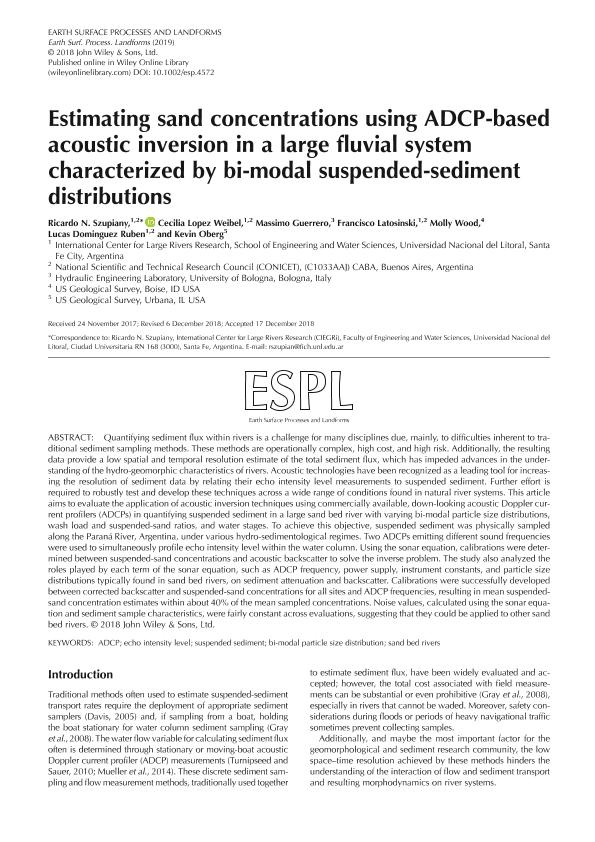Artículo
Estimating sand concentrations using ADCP-based acoustic inversion in a large fluvial system characterized by bi-modal suspended-sediment distributions
Szupiany, Ricardo Nicolas ; López Weibel, Cecilia
; López Weibel, Cecilia ; Guerrero, M.; Latosinski, Francisco Guillermo
; Guerrero, M.; Latosinski, Francisco Guillermo ; Wood, M.; Dominguez Ruben, Lucas Gerardo
; Wood, M.; Dominguez Ruben, Lucas Gerardo ; Oberg, K.
; Oberg, K.
 ; López Weibel, Cecilia
; López Weibel, Cecilia ; Guerrero, M.; Latosinski, Francisco Guillermo
; Guerrero, M.; Latosinski, Francisco Guillermo ; Wood, M.; Dominguez Ruben, Lucas Gerardo
; Wood, M.; Dominguez Ruben, Lucas Gerardo ; Oberg, K.
; Oberg, K.
Fecha de publicación:
12/2018
Editorial:
John Wiley & Sons Ltd
Revista:
Earth Surface Processes And Landforms
ISSN:
0197-9337
Idioma:
Inglés
Tipo de recurso:
Artículo publicado
Clasificación temática:
Resumen
Quantifying sediment flux within rivers is a challenge for many disciplines due, mainly, to difficulties inherent to traditional sediment sampling methods. These methods are operationally complex, high cost, and high risk. Additionally, the resulting data provide a low spatial and temporal resolution estimate of the total sediment flux, which has impeded advances in the understanding of the hydro‐geomorphic characteristics of rivers. Acoustic technologies have been recognized as a leading tool for increasing the resolution of sediment data by relating their echo intensity level measurements to suspended sediment. Further effort is required to robustly test and develop these techniques across a wide range of conditions found in natural river systems. This paper aims to evaluate the application of acoustic inversion techniques using commercially available, down‐looking acoustic Doppler current profilers (ADCPs) in quantifying suspended sediment in a large sand bed river with varying bi‐modal particle size distributions, wash load and suspended‐sand ratios, and water stages. To achieve this objective, suspended sediment was physically sampled along the Paraná River, Argentina, under various hydro‐sedimentological regimes. Two ADCPs emitting different sound frequencies were used to simultaneously profile echo intensity level within the water column. Using the sonar equation, calibrations were determined between suspended‐sand concentrations and acoustic backscatter to solve the inverse problem. The study also analyzed the roles played by each term of the sonar equation, such as ADCP frequency, power supply, instrument constants, and particle size distributions typically found in sand bed rivers, on sediment attenuation and backscatter. Calibrations were successfully developed between corrected backscatter and suspended‐sand concentrations for all sites and ADCP frequencies, resulting in mean suspended‐sand concentration estimates within about 40% of the mean sampled concentrations. Noise values, calculated using the sonar equation and sediment sample characteristics, were fairly constant across evaluations, suggesting that they could be applied to other sand bed rivers.
Archivos asociados
Licencia
Identificadores
Colecciones
Articulos(CCT - SANTA FE)
Articulos de CTRO.CIENTIFICO TECNOL.CONICET - SANTA FE
Articulos de CTRO.CIENTIFICO TECNOL.CONICET - SANTA FE
Citación
Szupiany, Ricardo Nicolas; López Weibel, Cecilia; Guerrero, M.; Latosinski, Francisco Guillermo; Wood, M.; et al.; Estimating sand concentrations using ADCP-based acoustic inversion in a large fluvial system characterized by bi-modal suspended-sediment distributions; John Wiley & Sons Ltd; Earth Surface Processes And Landforms; 44; 12-2018; 1295-1308
Compartir
Altmétricas



